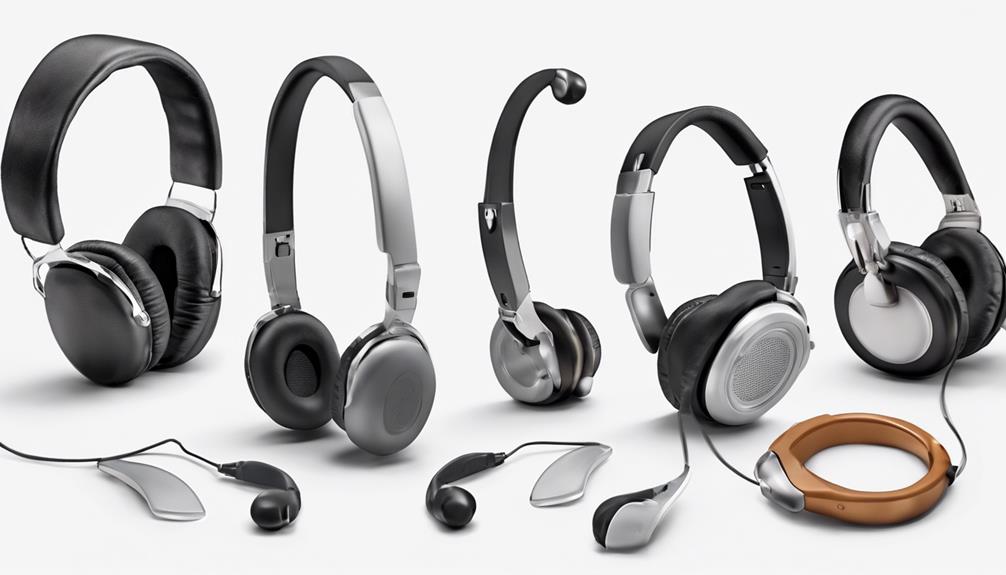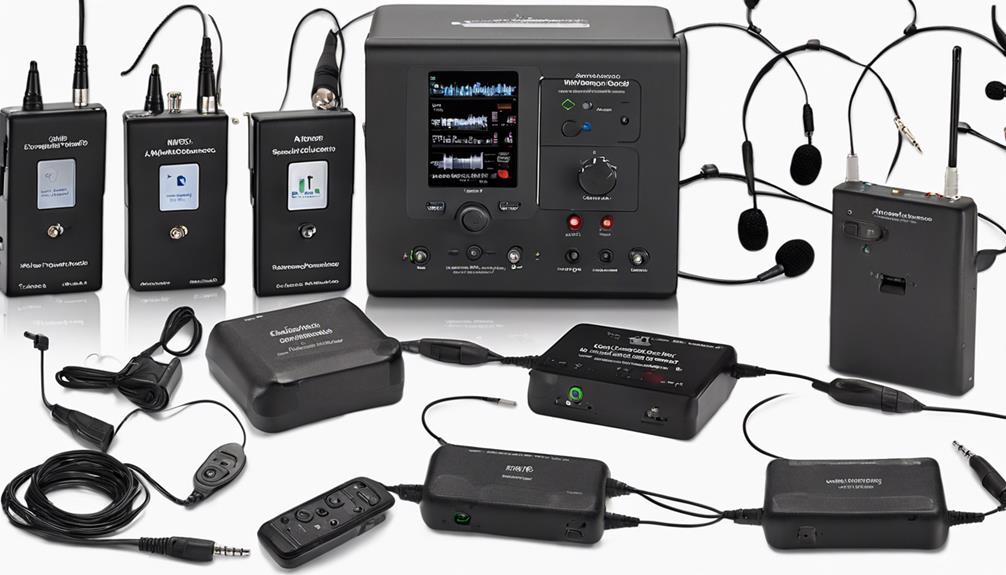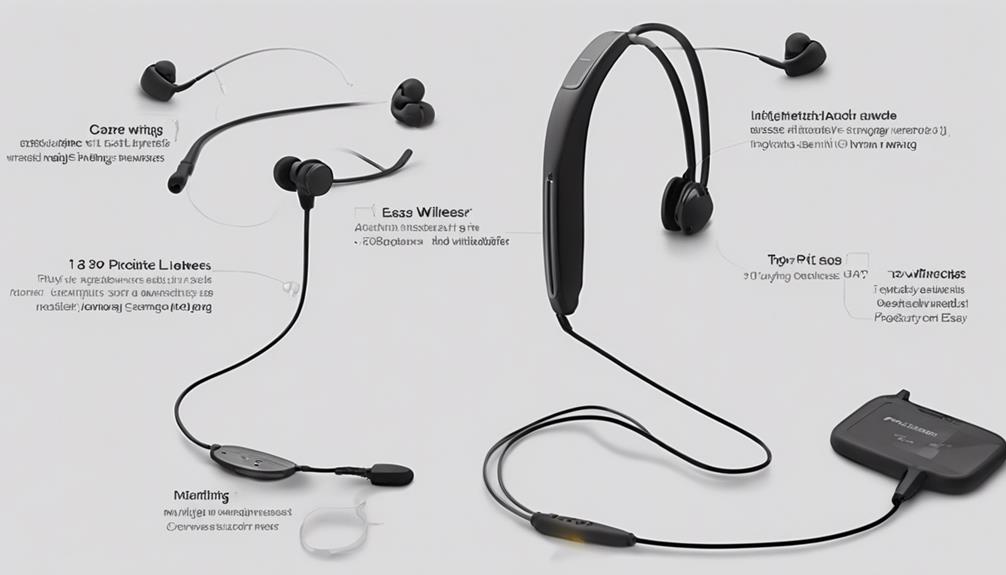When we think about enhancing communication for individuals with hearing difficulties, Infrared Assistive Listening Devices are typically one of the initial options we explore.
These devices employ a fascinating technology that transforms sound into light for transmission, providing a discreet solution for clearer listening experiences.
But what exactly makes these devices stand out in various environments and how do they cater to specific needs?
Let's uncover the functionalities and benefits of Infrared Assistive Listening Devices to explore their significance in overcoming communication barriers and improving auditory accessibility.
Key Takeaways
- Infrared ALDs convert audio to light for discreet transmission.
- They use infrared tech for efficient sound delivery.
- Ideal for enhancing hearing in various settings discreetly.
- Ensure secure signal transmission and customizable for diverse venues.
Understanding Infrared Assistive Listening Devices
Infrared assistive listening devices, employing light waves for sound transmission, are essential tools for individuals with hearing impairment. These devices, also known as infrared hearing systems, convert audio signals into light for transmission and then back into sound for the user.
Infrared systems are particularly useful in settings like homes and theaters, providing a discreet way to enhance hearing without disturbing others. One key advantage of infrared systems is their ability to offer privacy. This is due to the fact that Infrared light can't penetrate objects, ensuring that conversations remain confidential.
The installation process for these assistive listening devices is quick and straightforward. They can be easily integrated with existing audio systems, allowing for seamless operation. Understanding the principles behind infrared assistive listening devices is crucial for maximizing their benefits in various environments where improved sound transmission is necessary.
How Infrared ALDs Function

Infrared ALDs operate by utilizing infrared technology to transmit sound signals efficiently.
The transmission process involves microphones converting sound into infrared light signals for efficient delivery.
Receivers and transmitters play critical roles in decoding and encoding these light signals, respectively.
Infrared Technology Basics
Using a microphone, sound signals are converted into light signals for transmission in infrared assistive listening devices. These systems utilize infrared technology to ensure the secure transmission of audio signals.
Once the sound is converted into light, specially designed receivers within hearing aids or headphones decode the light signals back into audible sound for the user. Infrared technology is chosen for these devices due to its ability to provide privacy, as the light signals can't pass through objects, limiting the reception to the intended user.
This technology is commonly employed in various settings such as theaters, auditoriums, museums, and business meeting rooms to offer enhanced hearing assistance to individuals.
Transmission Process Explained
Regularly, light waves are harnessed by Infrared Assistive Listening Devices to convey audio signals to receivers, converting the audio source into infrared light for transmission.
- Conversion: The audio signal is transformed into modulated infrared light signals.
- Transmission: Infrared light waves carry the audio information to the receiver.
- Reception: Infrared receivers pick up the modulated light signals.
- Decoding: The receiver converts the light signals back into the original audio signal.
- Output: Users receive the audio content, enabling them to listen privately.
This transmission method ensures secure communication, making Infrared ALDs suitable for confidential environments like theaters and auditoriums where privacy is crucial.
Receiver and Transmitter Functions
Utilizing sophisticated technology, the receiver and transmitter functions of Infrared Assistive Listening Devices are crucial for converting and delivering audio signals efficiently. Transmitters within these devices are responsible for converting sound signals into light waves, which are then transmitted to receivers.
On the receiving end, the receiver decodes these light signals back into audio for the user to hear. This process ensures that individuals with hearing impairments can effectively access and comprehend audio content.
Additionally, the use of light signals in Infrared ALDs offers a level of privacy, as these signals can't pass through objects. This feature makes Infrared ALDs particularly suitable for environments where confidential communication is essential, such as theaters, auditoriums, and business meeting rooms.
Benefits of Infrared ALDs

Enhancing speech clarity and reducing background noise interference, Infrared Assistive Listening Devices (ALDs) provide significant benefits for individuals with hearing loss. These devices are designed to enhance sound quality and improve the overall listening experience for users. Here are some key benefits of using Infrared ALDs:
- Enhanced Speech Intelligibility: Infrared ALDs help individuals with hearing loss better understand spoken words by delivering clear and crisp sound directly to the user.
- Reduced Background Noise Interference: By minimizing distracting background noises, these devices improve the ability to focus on the desired sound, making communication easier.
- Customizable Listening Options: Users can adjust settings such as volume and tone to suit their personal preferences and hearing needs.
- Support for Multiple Channels: Infrared systems offer the flexibility of multiple channels, allowing for language interpretation services or accommodating various audio sources simultaneously.
- Confidentiality Assurance: The nature of Infrared technology prevents signal leakage, ensuring privacy during confidential conversations or sensitive discussions.
Types of Infrared Listening Devices

Infrared listening devices, categorized based on their design and functionality, offer a variety of options to cater to different user needs and preferences. There are several types of infrared systems available in the market.
The first type is stationary infrared systems, which are commonly used in theaters and auditoriums. These systems consist of fixed infrared radiators installed in the room, ensuring a secure and private listening experience for users.
The second type is portable infrared systems, which are suitable for situations where mobility is required, such as guided tours or outdoor events. Portable systems provide users with the flexibility to move around while still receiving clear audio signals.
Another type is infrared systems with noise reduction technology, which help in reducing background noise interference, ensuring speech intelligibility even in noisy environments. These devices are especially beneficial for individuals who struggle to hear in crowded or loud settings.
Features of Infrared ALDs

Light waves are utilized by Infrared ALDs to efficiently transmit audio signals to receivers in closed settings like theaters and meeting rooms. These devices offer various features that cater to the needs of users in challenging listening environments.
- Secure Communication: Infrared ALDs provide secure and confidential communication, ensuring privacy for users.
- Reduced Background Noise Interference: One of the key features of Infrared ALDs is their ability to minimize background noise interference, enhancing speech clarity and intelligibility.
- Multiple Channels: These devices support multiple channels, allowing for language interpretation and accommodating diverse user requirements.
- Ease of Use: Infrared ALDs are user-friendly, making them accessible and convenient for individuals of all technical abilities.
- Customizable Settings: Users can customize settings on Infrared ALDs to suit their preferences, providing a personalized listening experience tailored to their needs.
Applications of Infrared ALDs

Infrared ALDs find significant applications in various settings, including theaters, educational institutions, and museums. These systems facilitate hearing support and audio description in theaters, ensuring an inclusive experience for all patrons.
In educational environments, Infrared ALDs assist in language interpretation and distribution, enhancing communication accessibility.
Infrared ALDs in Theaters
Utilizing advanced technology, theaters implement Infrared ALDs to precisely deliver audio signals to assist individuals with hearing impairments during performances. Infrared ALDs in theaters offer various benefits:
- Transmits audio signals through light waves for individuals with hearing loss.
- Ensures clear sound delivery directly to compatible receivers.
- Provides customizable listening options for enhanced performance enjoyment.
- Prevents sound spillage and offers privacy for users.
- Supports multiple channels for language interpretation, catering to diverse audience needs.
Infrared ALDs for Education
Enhancing educational environments for students with hearing impairments, Infrared ALDs provide clear audio transmission and improve speech intelligibility in classroom settings. These devices reduce background noise, ensuring that students can effectively hear and comprehend lectures. Infrared systems are particularly suited for lecture halls, classrooms, and other educational settings where communication is crucial.
With the ability to support multiple channels for language interpretation, these ALDs benefit diverse student populations. By enhancing sound quality and minimizing distractions, Infrared ALDs help create an inclusive learning environment where all students can access information effectively.
In education, Infrared ALDs play a vital role in ensuring that students with hearing impairments have equal opportunities to participate and succeed in academic settings.
Infrared ALDs in Museums
In museums, audio descriptions for exhibits and displays are provided through the use of Infrared ALDs. These devices offer multichannel options for language interpretation during guided tours. Key facts about Infrared ALDs in museums include:
- Infrared technology ensures clear sound transmission in noisy museum environments.
- The devices enhance the visitor experience by providing tailored information about exhibits.
- Infrared ALDs enable individuals with hearing loss to fully engage with museum content.
- They can accommodate multiple languages for diverse visitor groups.
- The multichannel options allow for personalized audio experiences based on visitor preferences.
Customizing Infrared Listening Solutions

Customizing infrared listening solutions involves tailoring signal strength, channel selection, and coverage area to meet specific venue requirements effectively. Infrared listening solutions can be customized for various settings like theaters, classrooms, and conference rooms.
Users have a range of customization options available, including adjusting signal strength, selecting channels, and defining coverage areas to suit their unique needs. By fine-tuning these settings, users can ensure optimal audio quality, privacy, and compatibility with hearing devices.
Customized infrared systems can also support diverse functionalities such as multiple language support, assistive listening services, and audio description services. Tailoring these solutions not only enhances the overall user experience but also ensures seamless integration with existing audio systems.
This customization capability allows for a more tailored and efficient use of infrared listening solutions, catering to the specific requirements of different venues and user preferences.
Frequently Asked Questions
What Are Examples of Assistive Listening Devices?
Examples of assistive listening devices include FM systems, loop systems, and Bluetooth receivers. They enhance sound for individuals with hearing impairments in various settings.
FM systems amplify sound by wirelessly transmitting audio signals directly to the user's hearing device. Loop systems use electromagnetic fields to broadcast sound to hearing aids with T-coils. Bluetooth receivers connect to compatible devices for enhanced audio transmission.
These technologies improve auditory accessibility for users in diverse environments.
What Is an Infrared Audio System?
Infrared audio systems utilize light to transmit sound signals, providing individuals with hearing impairment enhanced speech clarity and reduced background noise. These systems convert sound into light signals, wirelessly transmitting them to special receivers. Infrared technology offers customizable listening options and privacy, as the light signals can't penetrate objects.
Widely used in theaters, auditoriums, museums, academic settings, and business meeting rooms, infrared assistive listening devices improve communication in various settings.
How Do Assisted Listening Devices Work?
Assisted listening devices work by converting audio signals into a form that can be transmitted and then converted back into sound for the user.
These devices are designed to provide clear and confidential communication in various settings.
Infrared technology is utilized to ensure privacy, as the light signals used can't pass through walls or objects.
This technology is commonly used in theaters and auditoriums for seamless integration with existing audio systems.
What Is the Difference Between Infrared and Induction Loop?
When comparing infrared and induction loop systems, it's crucial to understand how light waves and electromagnetic fields differ in transmitting sound.
Infrared's privacy benefits from its inability to penetrate objects contrast induction loops' signal overspill.
Infrared's flexibility in installation, customization, and channel support outshines induction loops in various settings.
These distinctions make the choice between them a matter of specific needs and environment considerations.
Conclusion
In conclusion, Infrared Assistive Listening Devices are like invisible sound wizards, transforming light into crystal-clear audio magic for users with hearing impairments.
With their ability to enhance speech clarity and reduce background noise, these devices open doors to a world of improved communication and accessibility.
Whether in a bustling theater or a quiet conference room, Infrared ALDs shine brightly in providing a tailored listening experience that brings sound to life in a whole new way.











